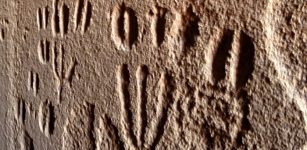Ehecatl: The Snake-Bird Deity And God Of Wind Feared And Respected By The Aztecs
A. Sutherland - AncientPages.com - Located in the Toluca Valley of highland central Mexico, Calixtlahuaca is one of the few Aztec-related urban sites, of which architecture and stone sculpture have survived until today.
Calixtlahuaca, a circular temple of Ehecatl, the Aztec god of wind. Image credit: INAH
Most of the settlement at Calixtlahuaca occupies the slopes of Cerro Tenismo, a small relict volcano. The Calixtlahuaca Aztec ruins near Toluca are scattered between the valley floor and the hill's summit.
The largest and best-known structure at Calixtlahuaca is a circular temple, where archaeologists discovered a life-sized stone sculpture of the Aztec god of wind, Ehecatl, which means 'Wind in Náhuatl.'
The Aztec codices confirm that Ehecatl was black with a conical head; he wore a red bird mask and shell jewelry, but his favorite piece of jewelry was a 'wind jewel' made of a conch shell.
Ehecatl was an important snake-bird deity (Quetzalcoatl) and god of air in the Aztecs' beliefs.
The Aztecs believed that the sound of the wind in the trees represented Ehecatl’s desire.
This deity symbolized fertility and human breath, which means this figure was closely associated with life force. The Aztecs believed that Ehecatl – by controlling all kinds of winds, even the strongest ones – could give life to Earth. Ehecatl's role was significant because he was credited with the creation of the present human race and the creation of the heavens.
One legend says that Ehecatl blew on the *sacrificial fire to stimulate the rising of the fifth sun and the fifth moon, the sun and moon of the present world, the fifth world. With such contributions, the Aztecs considered Ehecatl to be a creator god.
Left:Stone sculpture of Ehécatl, Wind God, National Museum of Anthropology, Mexico ; Right: Altar dedicated to the god Ehecatl, located in the middle of Metro Pino Suárez, Mexico City. Image credit: Thelmadatter - Public Domain
In Aztec myths and legends, Ehecatl plays an important role. One legend says that Ehecatl introduced sexual love to humankind; he once fell in love with Mayahuel, a maiden he brought from the Underworld. Their lovemaking caused a tree to grow.
The Aztecs believed that the sound of the wind in the trees represented Ehecatl's desire.
The Aztec codices confirm that Ehecatl was black with a conical head; he wore a red bird mask and shell jewelry, but his favorite piece of jewelry was a 'wind jewel' made of a conch shell.
Statue of Ehecatl-Quetzalcoatl, in the Brooklyn Museum (New York City). Life-Death Figure, 900-1250. (No restrictions)
The temples, which the Aztecs built to honor him, were circular-shaped with conical roofs to symbolize caves to the Underworld. According to one interpretation, a circle, which is endless and round, the temples' rounded corners may have represented the god Ehecatl's infinite powers.
One of the extraordinary finds made at the archaeological site of Calixtlahuaca during the XIX and XX centuries is a Romanesque figurine - a small terracotta head - unearthed in 1933 during the excavation of a burial offering in the Pre-Hispanic settlement of Tecaxic-Calixtlahuaca, located approximately forty miles NW of Mexico City.
It remains a mystery how it reached Caxtlahuaca, 40 km northeast of Mexico City. It is known the artifact is authentic and dates back to the 2nd century.
Written by – A. Sutherland AncientPages.com Senior Staff Writer
Updated on February 2, 2024
Copyright © AncientPages.com All rights reserved. This material may not be published, broadcast, rewritten or redistributed in whole or part without the express written permission of AncientPages.com
More From Ancient Pages
-
 Major Breakthrough: 1.4-Million-Year-Old Bones Discovered In Spain Rewrite History Of Human Evolution In Europe
Archaeology | Sep 29, 2022
Major Breakthrough: 1.4-Million-Year-Old Bones Discovered In Spain Rewrite History Of Human Evolution In Europe
Archaeology | Sep 29, 2022 -
 What Was The Medieval ‘Two Sleeps’ Habit?
Ancient History Facts | Jun 10, 2024
What Was The Medieval ‘Two Sleeps’ Habit?
Ancient History Facts | Jun 10, 2024 -
 Men Are Slowly Losing Their Y Chromosome – Is The Future Of Humanity In Danger?
Featured Stories | Nov 7, 2023
Men Are Slowly Losing Their Y Chromosome – Is The Future Of Humanity In Danger?
Featured Stories | Nov 7, 2023 -
 Why Are Statues Of Mythical Yeti Dividing People In The Himalayas?
Featured Stories | Feb 18, 2020
Why Are Statues Of Mythical Yeti Dividing People In The Himalayas?
Featured Stories | Feb 18, 2020 -
 Mystery Of The Vittrup Man – Bog Body Of A Foreigner In Neolithic Denmark
Featured Stories | Apr 15, 2024
Mystery Of The Vittrup Man – Bog Body Of A Foreigner In Neolithic Denmark
Featured Stories | Apr 15, 2024 -
 The Dove And The Pomegranate: Who Was The High-Ranking Lady Who Owned This Unique Artifact In The First Temple Period?
Artifacts | Aug 9, 2023
The Dove And The Pomegranate: Who Was The High-Ranking Lady Who Owned This Unique Artifact In The First Temple Period?
Artifacts | Aug 9, 2023 -
 Beer Was Used As Medicine And Payment In Ancient Egypt
Ancient History Facts | Feb 11, 2018
Beer Was Used As Medicine And Payment In Ancient Egypt
Ancient History Facts | Feb 11, 2018 -
 Secrets Of A Lake That Could Re-Write Ancient History Of America – Interesting Artifacts And Buildings – Part 2
Artifacts | Jun 5, 2018
Secrets Of A Lake That Could Re-Write Ancient History Of America – Interesting Artifacts And Buildings – Part 2
Artifacts | Jun 5, 2018 -
 Large Earthwork At Wichita Site In Kansas – Is It Long-Lost Native American City Of Etzanoa?
Archaeology | Sep 4, 2020
Large Earthwork At Wichita Site In Kansas – Is It Long-Lost Native American City Of Etzanoa?
Archaeology | Sep 4, 2020 -
 Spartacus: The Rise And Fall Of An Unlikely Hero
Featured Stories | Oct 4, 2022
Spartacus: The Rise And Fall Of An Unlikely Hero
Featured Stories | Oct 4, 2022 -
 Animal Tracks And Human Footprints In Prehistoric Hunter-Gatherer Rock Art In Namibia
Archaeology | Sep 13, 2023
Animal Tracks And Human Footprints In Prehistoric Hunter-Gatherer Rock Art In Namibia
Archaeology | Sep 13, 2023 -
 Marble Slab Production During Roman Imperial Time Was Much More Efficient Than It Is Today
Archaeology | May 14, 2021
Marble Slab Production During Roman Imperial Time Was Much More Efficient Than It Is Today
Archaeology | May 14, 2021 -
 First Animals On Earth Could Have Evolved Much Earlier Than The Oldest Fossils Suggest
Fossils | Oct 13, 2022
First Animals On Earth Could Have Evolved Much Earlier Than The Oldest Fossils Suggest
Fossils | Oct 13, 2022 -
 Proteus: Prophetic Greek Sea God Who Knew All Things, Past, Present And Future
Featured Stories | Jan 17, 2020
Proteus: Prophetic Greek Sea God Who Knew All Things, Past, Present And Future
Featured Stories | Jan 17, 2020 -
 Nastrond (Náströnd): Grisly Hall Of Corpses – Norse Vision Of Most Terrible Place In Niflheim, Kingdom Of The Dead
Featured Stories | Sep 13, 2019
Nastrond (Náströnd): Grisly Hall Of Corpses – Norse Vision Of Most Terrible Place In Niflheim, Kingdom Of The Dead
Featured Stories | Sep 13, 2019 -
 Ancient DNA Reveals The World’s Oldest Family Tree
Archaeology | Dec 27, 2021
Ancient DNA Reveals The World’s Oldest Family Tree
Archaeology | Dec 27, 2021 -
 British Museum Is World’s Largest Receiver Of Stolen Goods – Says QC
Archaeology | Nov 12, 2019
British Museum Is World’s Largest Receiver Of Stolen Goods – Says QC
Archaeology | Nov 12, 2019 -
 New Dating Of Intriguing Cave Art Reveals History Of Puerto Rican People
Archaeology | Oct 19, 2023
New Dating Of Intriguing Cave Art Reveals History Of Puerto Rican People
Archaeology | Oct 19, 2023 -
 True Colors Of The Parthenon Sculptures Revealed In New Study
Artifacts | Oct 12, 2023
True Colors Of The Parthenon Sculptures Revealed In New Study
Artifacts | Oct 12, 2023 -
 Ancient Maya Astronomers Predicted Meteor Showers 2 Millennia Ago – Mayan Hieroglyphic Inscriptions Reveal
Archaeology | Sep 12, 2017
Ancient Maya Astronomers Predicted Meteor Showers 2 Millennia Ago – Mayan Hieroglyphic Inscriptions Reveal
Archaeology | Sep 12, 2017




